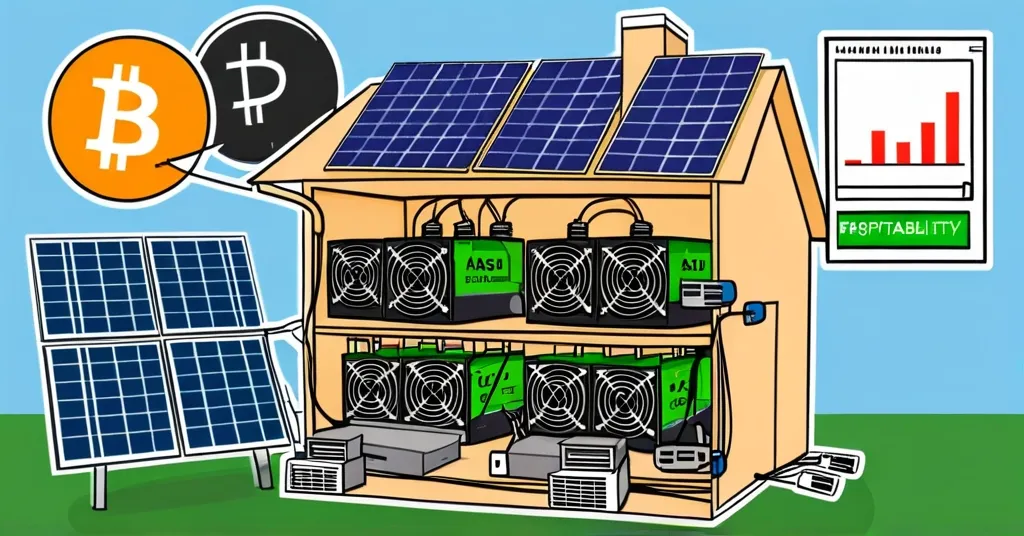Home Bitcoin Mining Guide: Set Up and Profit in 2024

Home-Based Bitcoin Mining: Your Step-by-Step Guide
Interested in turning your home into a Bitcoin mint? Here’s a no-nonsense guide to setting up your own home-based Bitcoin mining operation in 2024.
- Select robust mining hardware
- Calculate your electricity costs
- Choose the right mining software
- Decide between mining pool or solo mining
- Configure your system
- Assess profitability
Since the first Bitcoin block was mined on January 3, 2009, the world of cryptocurrency mining has evolved into a high-tech arena. While some purists might argue that home mining is a thing of the past, with the right setup, it’s still very much a viable venture. But let’s cut to the chase—home mining isn’t a walk in the park; it’s about strategizing and optimizing every aspect of your setup.
Choosing the Right Hardware
Your mining journey begins with the hardware. ASIC chips, or Application-Specific Integrated Circuit chips, are your go-to for Bitcoin mining. These specialized computers are designed solely for mining cryptocurrencies, offering a higher hash rate and efficiency compared to CPU, GPU, and FPGA alternatives. Brands like Antminer dominate the scene, and as the old saying goes, “Home-based Bitcoin mining will only be profitable if you establish it on solid hardware.”
Don’t get too excited about turning your living room into a digital Fort Knox, though. ASICs can be costly, and you’ll need to do your homework to ensure you’re investing in a model that suits your needs and budget. From Antminer S19 to Whatsminer M30S++, the market offers various options, each with different hash rates and power consumption rates. Choose wisely!
Understanding Electricity Costs
Electricity costs are the make-or-break factor in your mining venture’s profitability. Rates vary wildly depending on your location, with some areas offering rates as low as $0.12 per kWh. Crunching these numbers is essential, as high electricity costs can quickly turn your Bitcoin dreams into a financial nightmare. Remember, it’s about more than just “a house connected to a network with blue lights;” it’s about making the math work in your favor.
Selecting Mining Software
With your hardware in place, you’ll need to select the right mining software. Options like GGMiner, ASICSeer, BFGMiner, and Easy Miner are popular, each designed to work with different hardware and cryptocurrencies. Matching your software to your setup is crucial for smooth operations. Think of it as choosing the right tools for your digital mining camp.
Deciding Between Mining Pool or Solo Mining
Should you go it alone or join forces with others? Joining a mining pool like Slush Pool, AntPool, or F2Pool can significantly increase the frequency of your rewards. It’s like teaming up with other treasure hunters to share the workload and the bounty. For home miners, this often makes more sense than going solo, where you might mine for months without hitting the jackpot.
Configuring Your System
Setting up your system involves configuring your mining software with your pool’s URL, your miner name, password, and a cryptocurrency wallet address. It’s like setting up your digital mining camp, ensuring everything is in place before you start digging for digital gold. Don’t rush this step; a misconfiguration can leave you out in the cold.
Calculating Profitability
Profitability is where the rubber meets the road. You’ll need to consider your electricity rates, hash rate, network difficulty, mining pool fees, and the ever-volatile price of Bitcoin. Tools like the Cryptocompare calculator can help you estimate your monthly profits. For example, with Bitcoin prices at $101,683.16 and a network hash rate of 720,963,951,658 GH/s, you might see around $347.61 in monthly profits. But remember, these numbers are constantly shifting, so stay vigilant.
Optimizing Your Mining Setup
To get the most out of your setup, consider using renewable energy sources. Not only does this reduce your costs, but it also aligns with the growing push for sustainability in mining. Mining during off-peak hours can further enhance your efficiency, and proper cooling is essential to prevent your hardware from overheating. Engaging with the mining community can also provide valuable insights and troubleshooting tips.
“Thanks to advanced technology and highly efficient equipment, home-based Bitcoin mining can be a profitable undertaking in 2024.” But let’s not sugarcoat it—cryptocurrency investments carry inherent risks, and thorough preparation is your best defense against potential pitfalls.
Challenges and Counterpoints
While home mining can be lucrative, it’s not without its challenges. The environmental impact of Bitcoin mining is a hot topic, with the industry consuming around 127 terawatt-hours annually. However, the shift towards renewable energy sources like solar, wind, and hydropower is transforming the landscape, making mining more sustainable and even contributing to grid stability.
Regulatory risks also loom large, with governments around the world taking varying stances on cryptocurrency mining. Yet, the decentralized nature of Bitcoin and the ethos of financial freedom and privacy remain strong counterpoints. As a champion of decentralization, it’s crucial to weigh these pros and cons carefully.
Moreover, while Bitcoin remains the king of cryptocurrencies, acknowledging the roles of other blockchains like Ethereum in the ecosystem is important. Each has its niche, and together, they drive the financial revolution forward.
Key Takeaways and Questions
What is the first step to setting up a home-based Bitcoin mining operation?
The first step is to evaluate your setup requirements, focusing on choosing solid hardware, considering electricity costs, and ensuring adequate space.
What are the advantages of using ASIC chips for Bitcoin mining?
ASIC chips are specifically designed for cryptocurrency mining, providing better output and efficiency in terms of hash rate power, making them more suitable for home mining.
How does joining a mining pool benefit home miners?
Joining a mining pool allows home miners to collaborate with others, increasing the efficiency of their network and ensuring more frequent rewards.
What are the key factors to consider when calculating mining profitability?
Key factors include local electricity rates, hash rate and network difficulty, mining pool fees, and the price volatility of the cryptocurrency being mined.
What are some tips for optimizing a home-based mining setup?
Tips include using renewable energy sources, increasing mining activities during off-peak periods, ensuring hardware cooling to prevent overheating, and engaging with the mining community for shared knowledge and troubleshooting.
So, are you ready to transform your home into a hub of digital currency? With careful planning and the right approach, home-based Bitcoin mining can be both an exciting and rewarding venture. Just remember, in the world of crypto, there’s no such thing as a free lunch, but with diligent work and a bit of luck, you might just strike it rich.



